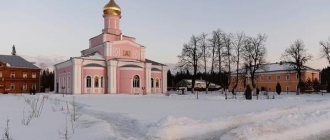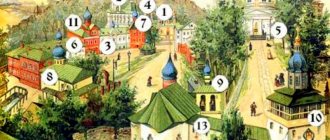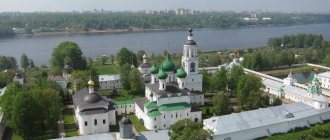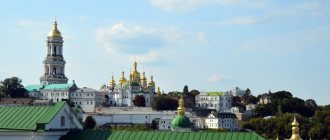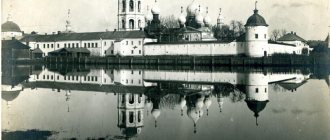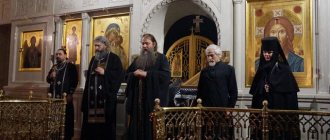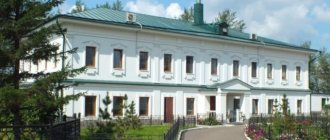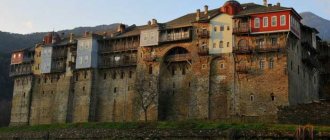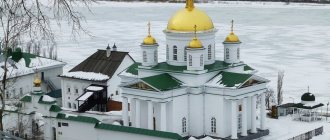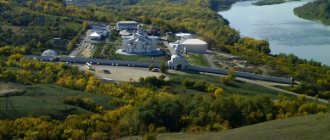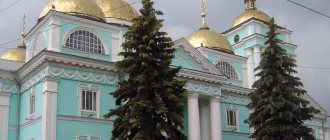I have long wanted to visit the Holy Dormition Dalmatovo Monastery, about which I heard and read a lot, but somehow it didn’t work out. However, by a happy coincidence, the trip still took place - thanks to the chairman of the city society of the visually impaired, Tatyana Bganina. Community activists were making a day trip there one September day, and she invited me to join. Which I did with pleasure. I wanted to understand at least a little - as they say, from the edge - into the meaning of monastic life. To be honest, I thought not to go into the church, but just to meet one of the monks, walk around the territory, look at the remains of the Assumption Cathedral, the Southwestern Tower, the fraternal building, that is, everything that has not yet been restored. But in the end, having received the blessing, we even saw the relics of St. Dalmatian. They say that by venerating the relics, you can heal any ailment.
The Holy Dormition Monastery in the Trans-Ural town of Dalmatovo is a unique Orthodox architectural monument of federal significance, the only complex of its kind in the entire Middle and Southern Urals. It was founded in 1644 by the monk Dalmat, in the world Dmitry Ivanovich Mokrinsky (1594-1697). Before the October Revolution, the monastery had a rich library and valuable archives. But during the Soviet era, although the monastery was not completely destroyed, it also suffered the same fate as many holy places.
Something from history
Dalmatovo is a small Trans-Ural town. It is interesting because some of the main attractions of the Kurgan region are concentrated here. It so happened that the life of the city of Dalmatovo has always been closely connected with the Dalmatovsky Assumption Monastery, located on the left bank of the Iset River.
The monastery was founded back in 1644 by a descendant of one of the Cossacks from the squad of the legendary Ermak - Dmitry Ivanovich Mokrinsky. Having embraced faith after the death of his beloved wife, he chose the name Dalmatian. At first, Dalmat lived on the banks of the Iset in a cave he dug in clay. Then he founded a monastery, near which a settlement soon arose. In 1691, after the name of the wooden church of St. Nicholas the Wonderworker erected in the center of the village, the settlement was named the village of Nikolaevsky.
The monastery was burned to the ground more than once by the Bashkirs, Tatars and Kalmyks, who tried to oust the Russians from their former lands. From 1707 to 1720, the first stone building in these trans-Ural places was built here - the three-altar Assumption Cathedral.
In those same years, the monks built impregnable stone walls with two high towers. They were built well, to last. The walls of the Dalmatovo Monastery became the most reliable fortification of these places. They had to experience a lot of things. For example, in February 1774, when almost the entire Urals was engulfed in the “Pugachev war,” a huge five-thousand-strong Pugachev army led by Ataman Pesterev approached the walls of the Dalmatov Monastery. There were an order of magnitude fewer defenders of the monastery fortress - only about four hundred. The villagers were also hiding behind the walls of the monastery. The fierce struggle for the Dalmatovo Monastery lasted from February 11 to March 2, 1774. The Pugachevites fired cannons at the monastery, tried to get to the walls, hiding behind carts of hay, but received fierce resistance. The Dalmatovians set fire to carts of hay, and the rioters were fired at with guns and thrown with stones. The Pugachevites retreated. And after the suppression of the unrest, in 1881, Empress Catherine II, for her courage in defending the monastery, granted the village of Nikolaevsky the title of the district town of Dalmatovo.
Having survived many difficult trials and uprisings, the Dalmatovo Monastery fell under the yoke of the Bolsheviks. However, we will return to its rich and, in its own way, tragic history, but for now the excursion bus, driving along the central street of the city, took us to the northern monastery gate.
History[edit]
St. Dalmatian is widely revered in the Urals and Siberia. His icons, particles of his relics are in many churches of Kurgan, Yekaterinburg, Chelyabinsk, Omsk, Novosibirsk and other dioceses. Since 1871, the monastery kept records of miracles through the prayers of the monk; about 30 such testimonies from the early 19th century have been preserved in the monastery archive.
The Holy Dormition Dalmatovo Monastery of the Kurgan Diocese of the Russian Orthodox Church was founded in the 17th century, on the lands of the Tatar Murza Iligei, and became the first Russian territory in a foreign land. The 3rd class monastery was founded in 1644 on the banks of the Iset River in a place called “White Settlement” by the elder of the Nevyansk Epiphany Monastery, monk Dalmat, in the world - Tobolsk mayor Dimitry Ivanovich Mokrinsky (1594-1697). It all started when Elder Dalmat dug a cave for himself in a ravine, on the banks of the Iset, at the confluence of the Techa River, and then he brought the miraculous Dalmatian icon of the Dormition of the Mother of God. At first this monastery was called the Assumption Isetsk Hermitage, sometimes the Dalmatovskaya Hermitage.
Carrying out missionary activities, the monastery peacefully developed deserted, uninhabited places, settling the arriving Christians in the settlements and villages that were being created.
Dalmatovsky Assumption Monastery, photo in a magazine
The formation and development of the monastery was not easy and the monks often faced fierce struggles; often the walls of the monastery were attacked by its enemies; for many years the monastery lived in fear in anticipation of an attack. With the help of God and the help of good people, the monastery survived the hardships and hardships; more than once it was necessary to rebuild almost from scratch.
There were three churches in the monastery: the Assumption main church, the Dmitrievskaya side church, and above the eastern holy gates - in the name of John the Theologian. Inside the fence there were: a wooden abbot's cell, Elder Dalmat's cell, four wooden fraternal cells, between the cells there was a small shed where the coffin of Elder Dalmat was located, a cellar with a canopy and a cellar, a grain cell, a kvass cookhouse, a malthouse, a tanner's cell, a cellar, ten barns .
In October 1666, an abbot was established in the monastery and from among the monks, Abbot Isaac was appointed as the first clergyman. In the same year, Alexey Artemyev (named Afanasy) was tonsured a monk. In 1669, Elder Nikon became hegumen, and a year later - Joseph, and then Afanasy became hegumen.
Dalmatovsky Assumption Monastery, top view
The Dalmatovo monastery, which arose from the lonely desert of a hermit and turned into a community of monks, was of great importance in the Christianization of the region. The construction of temples and chapels began in many villages. Monastic lands are rich natural lands that attract newcomers and they settled here. Villages and settlements begin to form, and churches are built in them. Overcoming a multi-day journey, the migrant peasants, having reached here, had the opportunity to live and work on free and fertile lands near the village. Vast forests were both breadwinner and shelter for many; by clearing a clearing or cutting down a plot in the forest, they set up earthly refuges here for themselves and their families.
By attracting newcomers to its lands, the monastery provided them with “benefits” and tried in every possible way to help. Over time, the monastery acquired buildings - stables and cattle yards, barns, barns, mills, forges, premises for tanning leather, sewing shoes, and dresses.
Through the labors of the monastic brethren and peasants, as well as the contributions of well-willed lovers of Christ, the holy monastery became strong and increasingly moving towards prosperity and prosperity. But the monastery also had difficult times.
After reconciliation with Iligei, other enemies appeared for Dalmatia - also from foreigners. The Kalmyks wandering across the steppes approached the southern borders of the Siberian lands and made a sudden raid on the banks of the Iset and Techa, near the White Settlement. They, like wild animals, attacked the home of Dalmatus and his brethren, burned the chapels, then tortured the hermits themselves, killed some, and took others into captivity. Few were able to save their lives. Among them is Elder Dalmat, who took with him the icon of the Dormition of the Mother of God. The icon was almost not damaged in the fire; only one corner of it was scorched, which was touched by the daring hand of the enemy of the Gentile.
Dalmatovsky Dormition Monastery, this is what the monastery looked like
After the restoration of the monastery, it was besieged three more times by Kalmyk enemies. The first time was in 1662, when a riot was carried out, according to the Seit conspiracy - “Seitsky revolt”, by the princes Davlet-Girey and Kuchuk, descended from the family of Kuchum, the last Siberian Khan. The second time was in 1704, during the revolt of Adlar-Bai Isekeev. The third time the monastery was besieged in 1736, during a riot that began under the influence of Pepeni, Maidor and Tulchusur.
But after the Kalmyk raids, the monastery was besieged by other enemies - two gangs of robbers, known under the names of Dubinshchina and Pugachevshchina. The first gang was formed in 1762 from the Iset monastic volost on the occasion of the establishment of states, under the leadership of seditious exiles here. 10 years after the Dubinshchina, the monastery was besieged during a riot carried out by the impostor Pugachev. In mid-February 1774, an army of three thousand Pugachevites approached the Dalmatovsky Monastery. Only four hundred defenders took refuge behind the walls of the fortress. A twenty-day siege of the monastery began. The rioters tried to take the monastery by storm, but received fierce resistance. More than once the Pugachevites, under the cover of artillery and rifle fire, tried to get to the walls, hiding behind carts of hay, but the defenders of the monastery set fire to the hay with burning tow and literally bombarded the enemy with bullets and stones. Reinforcements approached the rebels, and their number exceeded five thousand. The situation was critical, but the monastery was saved by the rapid advance of government troops under the command of General Delong. During the 15-day siege (from February 15 to March 1), the Pugachevites were unable to penetrate inside the monastery fortification. Having lost 4 cannons and 200 men under the monastery walls, on the morning of March 1 the rebels retreated.
Courtyard, view of the southwest tower
Devastating fires of wooden buildings after raids by nomads and due to human negligence from 1651-1852. inspired the monks to build a stone monastery. In 1704, “the Bishop’s blessing was accepted to build a stone church on the White Hillfort in the name of the Most Holy Theotokos, Her honorable and glorious Assumption, in order to avoid the fiery ignition.” Each stone of the magnificent ensemble was cared for by the hands of the peasants of the Dalmatovo volost. The monastery wall, built almost 300 years ago, is the main attraction of the city of Dalmatovo.
In the history of the monastery there are hundreds of names, known and unknown, who contributed rich and meager gifts, in the hope of God's protection, many historical figures connected by fate with the monastery. These are the abbots and builders of the monastery, these are exiles who served time here, these are skilled craftsmen and icon painters, whose skill has carried through years of neglect.
After the revolution in the early 20s. the monastery was turned into a museum in the late 20s. services have been terminated. In 1930, the only Dalmatovo Museum-Monastery in the Urals was closed, and in the same year the domes were demolished from the Church of Sorrows. The main shrine, the miraculous Dalmatian Icon of the Mother of God, has disappeared and its whereabouts are currently unknown. Through the efforts of local historian and scientist V.P. Biryukov, most of the monastery archive was saved and taken to Shadrinsk. During the years of Soviet power, various institutions were located on the territory of the monastery, including. theater, the main destruction occurred in the post-war years from 1945, when the monastery complex was given over to -. The main temple of the monastery - the Assumption Cathedral - was beheaded, converted into a workshop, and the bell tower was demolished. The monastery wall was partially destroyed, the northwestern tower, the “Red Bastion,” was dismantled. Factory workshop buildings and a city boiler house were built on the territory of the monastery. Resolutions of the Council of Ministers of the RSFSR of 1952 and 1974. the complex of the Dalmatovsky Monastery is recognized as a historical and cultural monument of republican (all-Russian) significance.
Brothers of the monastery
In September 1989, an Orthodox community was registered in the city of Dalmatovo and the Sorrow Church was transferred to it, and on May 6, 1992, by decision of the Holy Synod of the Russian Orthodox Church, the monastery was revived and monastic life was resumed. left the monastery territory. On February 23, 1993, in connection with the separation of the independent Kurgan diocese from the Sverdlovsk diocese, the monastery changed its diocesan subordination. In 1994, the relics of St. Dalmata of Isetsky is a locally revered saint; since 2004, with the blessing of His Holiness Patriarch Alexy 11 of Moscow and All Rus', he has been a member of the Council of Siberian Saints; for the 300th anniversary of the saint’s repose in 1997, a service and akathist were compiled for him. Also in 1994, there was a strong fire in the monastery, the southwestern buildings burned out. Currently there are 9 people in the brethren of the monastery, incl. 4 monastics, abbot - Abbot Varnava (Averyanov). Operating churches: in honor of the icon of the Mother of God “Joy of All Who Sorrow” with a baptismal church in honor of the Cathedral of Sts. 70 Apostles, Gate Church of St. Apostle and Evangelist John the Theologian. There is a Sunday school and an Orthodox library. There is a hotel for pilgrims; male pilgrims are accommodated in the fraternal building.
In the refectory
The territory of the monastery seemed quite vast, but strangely deserted. However, judging by the occasional meeting and rushing somewhere of people in monastic cassocks and without them, life here goes on as usual. We were greeted warmly, accompanied by a handsome, tall monk of about thirty-five years of age. He asked brother Nikita to contact him. First of all, our “guide” took us... to the refectory - lunch time was approaching.
People gathered near a two-story building with a high porch. I didn’t see any monks among them - apparently, either they were already inside, or they were entering the refectory from another entrance. Our group consisted mainly of women, but the population of the monastery was almost entirely male, which, however, is not surprising - after all, the monastery is for men. It turned out that in addition to monks and novices, there are also simply employees and so-called workers living here, but I’ll tell you about them a little later.
The refectory, as Brother Nikita explained, was like that even before the revolution, only one-story, and the second floor was small - rather a superstructure where the bishop's chamber was located. Today, the refectory occupies the second floor, and the first floor houses a carpentry shop: all carpentry for the temple and monastery is made by hand. A wooden tower has been preserved at the top, which since ancient times served as an observation tower. After all, close to the territory of the monastery, about twenty meters from the fence, the Iset River flows, along which all the main traffic used to flow. He was being watched from the tower.
Men enter the dining room first, then women are allowed in. All those who enter stand in complete silence at long tables, waiting for a short prayer, which the monks read before each meal (and after the meal, too). By the way, although we didn’t see any meat on the table, the food turned out to be very tasty - cream of mushroom soup, buckwheat porridge, vegetable salads and even dessert in the form of melon pieces.
After a hearty lunch, Brother Nikita took us around the monastery grounds. This excursion turned out to be very interesting and educational.
In recovery stage
The Holy Dormition Dalmatovo Monastery is a historically established architectural ensemble of buildings built in the 18th-19th centuries. It includes fortress walls with towers and gates, the Assumption Cathedral and the Church of All Who Sorrow to the Joy of All Who Sorrow, monastery cells, and service buildings. The total area of the monastery within the walls is 4 hectares. After decades of Soviet neglect, the monastery was again transferred to the Russian Orthodox Church in 1992. Currently, it is operational, although many buildings are in unsatisfactory condition, restoration and restoration work is underway. To date, the Sorrow Church, the chapel-tomb of St. Dalmatus, the gateway Ionic Theological Church, the chapel in front of the entrance to the monastery, and the northern cells have been restored (now there is a museum here).
The oldest stone building on the territory of the monastery is the Assumption Cathedral, built in honor of the Dormition of the Mother of God. This is the very first stone cathedral in the Urals and Siberia. The building is three hundred years old, and, as brother Nikita put it, “if it had not been touched, it would have stood for another three hundred.” Now huge amounts of money are needed to restore it. There is hope that funds will be found, because the monastery is recognized as an architectural monument of federal significance. Each of its buildings bears the stamp of the era, the stamp of the talent of many generations of their creators. The monumental monastery buildings embodied the art of folk craftsmen - architects, artists, craftsmen...
Our guide showed the dilapidated building of the first theological school in the Urals, the once richest monastery library. Very slowly, but still, the restoration of the fraternal corps is underway. Today, the brethren live in the building next to the refectory. It was preserved because during the Soviet years the plant management was located here. Currently there are 20 people in the brethren: 15 monks and 5 novices. Since 1997, the abbot of the monastery has been Abbot Varnava (Averyanov).
In the monastery, as in former times, there are various workshops: a forge, a carpentry shop, a bakery, a candle shop, a cheese shop (which means there is also a herd of cows), a sewing workshop, a greenhouse, and an apiary. Only instead of monastery peasants, so-called workers work here. Who are the workers, we asked brother Nikita. To which he replied:
“These people work for the glory of God, for shelter and food. Any person can come to the monastery, ask to live and, if blessed, stay. It's okay because everyone can get confused in this life. And here there is time to understand yourself, think about God and the soul. Get away from vanity and temptations, understand why man was created. I myself was a worker at one time.
Among the workers there are different people - both those who have served time and those who have nowhere to live. Of course, unlike monks, they can leave the walls of the monastery at any time, but most of them simply have nowhere to go, and here they have both shelter and food. Including spiritual, which is so necessary for all of us.
Belfry near the northern gate
The territory of the monastery occupies 4 hectares
The ancient walls of the monastery - with loopholes for guns
The Assumption Cathedral was destroyed during the Soviet years and requires restoration
DALMATOVSKY MONASTERY IN HONOR OF THE DORMSION OF THE HOLY VIRGIN
Initially, a wooden chapel and cells were built in the D. m. In 1651, during a Kalmyk raid, the buildings were burned, and a church was soon erected. in honor of the Dormition of the Most Rev. Theotokos with a chapel in the name of St. Dimitry Prilutsky. According to the description, Assumption C. “The measure from the royal gates to the church doors is one and a half fathoms, three fathoms with an arshin in width, one and a half fathoms in height to the ceiling. The holy altar is one and a half fathoms long and three wide” (GA Shadrinsk, Kurgan region. F. 224. Op. 1. D. 3. L. 1-4 volumes). Above the east St. gates were built in 1673 and in 1683 with the blessing of Metropolitan. Siberian Pavel consecrated c. in the name of ap. John the Theologian. The monastery was fortified with a fort with watchtowers. According to the description of 1691, in the fence there were also cells (abbot, Elder Dalmata, 4 brethren), a bread room, a cookhouse, a kvass room, a malt room, a tannery, a large cellar, “cut into two”, a warm cellar, barns “for wheat flour, rye , oatmeal and for pushing”, barns “for wheat, oats, barley, hemp seed”, “small barn for malt” and a number of outbuildings, behind the fence there was a forge, horse and cow palaces (GA Shadrinsk, Kurgan region. F. 224. Op. 1. D. 3243. L. 177 vol. - 179).
Cathedral in honor of the Dormition of St. Mother of God. 1707–1719 Photo. Con. XIX century Cathedral in honor of the Dormition of St. Mother of God. 1707–1719 Photo. Con. XIX century
Almost all the wooden buildings of the monastery were destroyed by fires in 1707 and 1708. On the site of the Assumption Church, a cobblestone chapel was “hurriedly” (1709) erected over the burial place of St. Dalmata: “Measuring inwards, this chapel is four fathoms long, two fathoms and two arshins wide, covered with planks on two slopes” (Ibid. D. 157. L. a). In the chapel there were relics, according to legend, that belonged to the founder of the monastery - a helmet, chain mail (now in the Sverdlovsk Regional Museum of Local Lore) and schematic vestments. In 1871, in connection with the construction of the stone Sorrow Church. the chapel was moved to the monastery castle.
The surviving complex of buildings was formed mainly in the 1707-1760s. The monastery was the first stone monastery to be built in the Urals and Siberia and the largest stone ensemble after the Tobolsk Kremlin. In the center of the complex is the Assumption Cathedral (1707-1719), to the west of it and on the same axis is the c. in the name of the icon of the Mother of God “Joy of All Who Sorrow” (1871-1881); Along the perimeter of the monastery site there are administrative, economic and residential buildings.
Assumption Cathedral (the upper altar is in honor of the Dormition of the Blessed Virgin Mary, the lower altar is in honor of the Nativity of Christ) - one of the most grandiose stone structures in the Urals and Siberia, the first 2-story temple on these lands (not counting churches with basements) and one of the first built in Naryshkin style.
The blessing for the construction of the cathedral was given in 1704. On December. In 1705, a contract agreement was concluded with apprentice Ivan Borisov Soroka, a Yaroslavl resident who worked as part of a Moscow artel in Verkhoturye, then in Tyumen. The foundations of the stone cathedral were laid in the summer of 1707 to the east of the wooden cathedral church that burned down in January of the same year. In 1708, with the help of a Solikamsk artel invited from Verkhoturye, a refectory of the lower center was erected. Nativity of Christ (consecrated on December 9, 1711) with a chapel in the name of St. Demetrius of Prilutsky (consecrated March 19, 1710). Construction of the upper Assumption Church. began in 1713 with the help of a local artel of masons, formed at the previous stage of construction, headed by Yakov Gordeev Smirnykh; the construction of a stone church with a wooden refectory was completed by 1717 (consecrated on August 13, 1720). The construction of the stone bell tower over the porch was completed by 1719. Construction was carried out not only on the monastery, but also on the state. facilities. The architecture of the temple has reached the present day. time with significant distortions, its original appearance can be reconstructed according to the description of 1730.
The lower Church of the Nativity of Christ is 4-pillar, 2-light, with a 3-part altar and semi-circular apses in plan. Adjacent to it from the west is a single-pillar refectory, expanded to the south, and even further west is a porch with a bell tower (not preserved) above it. From the north, the chapel of St. is attached to the main volume of the lower church. Demetrius of Prilutsky with a semi-circular apse and refectory, narrow west. the porch of the aisle is connected by a passage to the north. wall of the refectory of the Church of the Nativity. The aisle was covered with a box vault, and its refectory was covered with a closed vault. Afterwards Here the burial of Archimandrite was arranged. Isaac.
Upper Uspenskaya c. placed exactly above the lower one, its small 5-sided apse is above the west. part of the altar of the lower church, with which it is connected by an internal staircase. The Assumption Church is pillarless, 5-domed, with side domes on light hatches located on the cardinal points. Lucarnes are included in peculiar pediments, built on the principle of a torn scroll frame. Between the upper church and the bell tower there was a narrow wooden porch with a roof on stone pillars. North and south doors led from the temple and from the porch to the walkway, built on the vaults of the refectory of the lower church, as well as on the vaults of the side porch and refectory (from the north) and the balcony-gallery (from the south). From the north-west On the side of the temple there was a stone porch (rebuilt and destroyed in the 20s of the 20th century) with a 2-flight wooden staircase leading to the porch of the upper temple. The tented bell tower rose above the stone tent-book depository, built over the west. porch.
In the decor, along with Naryshkin forms, known from the decor of temples in Verkhoturye (3/4-columns with “Corinthian” capitals (apses), cornices from brackets-cubes, scroll casings with strongly twisted ends (summer temple) or connected by a horizontal lintel (winter temple)), there are elements of patterning characteristic of Solikamsk: a “bug” ornament in the frieze, platbands with 3-bladed frames, profiled blades with fly inserts (the “tile” is made in brick). The principle of vertical connection of the columns framing the windows of the lower church, as well as the shape of the half-columns with palm-shaped endings dividing its facades into “spreads” are reminiscent of the motifs of the architecture of Left Bank Ukraine.
Church in honor of the icon of the Mother of God “Joy of All Who Sorrow.” 1871–1881 Photo. Con. XIX century
Church in honor of the icon of the Mother of God “Joy of All Who Sorrow.” 1871–1881 Photo. Con. XIX century
The volumetric-spatial structure of the D. m. cathedral - the two-height lower church, its combination with the pillarless upper one - is unique. These features can be explained if we assume that it was conceived as a traditional one. for the 17th century a one-story, 4-pillar cathedral, and the decision to build an upper temple was made during the construction process. The only example of a 2-story pillar church is the Transfiguration Cathedral in Tambov (the upper church here has 6 pillars, like the lower one), and its composition arose due to a change in design during the construction process. The upper church of the D. m., to a greater extent than the lower one, is oriented towards the new, Naryshkin style: instead of semi-circular apses, they are faceted, the crowning is made according to the model of the Cathedral of St. Trinity in Verkhoturye (1703-1709).
The architecture of the D. M. Cathedral has undergone numerous changes. During the fire of 1742, all its wooden elements were destroyed. The cemetery and domes were restored, and instead of the wooden porch of the 2nd floor, a cruciform refectory was erected. In the 70s XVIII century repair work was carried out again: the construction of new domes “instead of the previous immoderately large ones,” and 4 additional domes were placed in the corners of the quadrangle. In 1769-1774. the 9-domed Baroque Pokrovskaya Church was built. in Turinsk, which became one of the main architectural models for temples in the Urals and West. Siberia, and, probably, it was under its influence that the cumbersome domes of the cathedral (apparently of the Ukrainian type) were replaced by nine domes.
During the same period, the picturesque decoration of the cathedral was created (not preserved). In 1752-1755. Tobolsk masters made the iconostasis of the Assumption Church, in 1766-1768 - its murals (artists Ilya Aslamov and Mikhail Kozmin), in 1768 - the iconostasis of the chapel of St. Dimitry Prilutsky (artist Aslamov). In 1771-1773 Matvey Volkov from Tobolsk and Alexander Shapochnikov from Verkhoturye painted the wooden refectory of the upper church, and they also worked in the lower church. Less responsible artistic and carpentry work was carried out by local craftsmen, of whom Jerome stands out. Vladimir.
In 1812 in the south. parts of the refectory c. The chapel church was consecrated on the Nativity of Christ. in the name of ap. John the Theologian. In 1852, a fire again destroyed the wooden elements of the cathedral and also severely damaged the stone ones. The restoration of the cathedral was carried out with significant adjustments: by 1854, instead of the 9-domed one, the 5-domed crown of the temple was restored, in 1856-1859. Instead of a wooden one, a stone refectory was erected on the 2nd floor (a chapel in honor of the Nativity of the Blessed Virgin Mary was placed in it) in forms imitating the architecture of the cathedral of the early years. XVIII century; the bell tower was “built”.
In 1932, all the crowning parts of the cathedral and the bell tower were destroyed; after being placed here in 1945, the cathedral was built on.
Stone fortress walls with gates and bastions had been erected since 1713. By 1730, the eastern part was basically completed. part of the monastery walls, in 1731-1763. work was carried out in Western. In plan, the monastery walls form an irregular hexagon. The entrances to the monastery were oriented to the cardinal points, with St. the gate (20s of the 18th century) was located on the corner formed by the north-east. and southeast walls. South the wall is flanked by octagon-shaped towers on a quadrangle with stone tents (the south-eastern tower was completed by 1730, the south-western one was built in 1731). North-East angle in the 20s XVIII century was decorated with a bastion, on the corner formed by the west. (dismantled in 1951) and north-west. walls, was the so-called. Red bastion with a low figure-of-eight top (destroyed in 1951). Some sections of the wall included residential and service spaces; to the end XVIII century to the south and zap. the walls were built into the abbot's, fraternal, so-called. workshops, premises on 1-2 floors.
The construction of the monastery buildings was carried out by a local artel, which was formed during the construction of the cathedral. Due to interruptions in the flow of funds for the protracted construction in D. m., the masters of the artel often left for different Siberia. cities. In the 30-60s. XVIII century mention is made of the participation of Dalmatian masters in works in Tobolsk, Verkhoturye, N. Tagil, Yekaterinburg, Kondinsky Monastery on the Ob, as well as in Yeniseisk; one can assume their participation in the construction of cathedral churches in Krasnoyarsk and Verkhneudinsk (now Ulan-Ude). Partially preserved c. St. Nicholas the Wonderworker ex. Podmonastyrskogo village Nikolaevsky (modern Dalmatovo; founded in 1753, consecrated in 1763, northern aisle - in the name of the Three Saints, 1771-1776), the decor exactly repeats the expressive forms of the lower part of the cathedral (columns with a palm-shaped ending, etc.) . Peculiar and c. Nativity of St. John the Baptist in the village. Shirokovsky (1784-1793) not far from Dalmatovo, where, despite the late date of construction, not only decorative forms were reproduced in miniature, but also the wedding of the Assumption Cathedral of D. m.
Above the east St. the gates were laid no earlier than 1722. in the name of ap. John the Theologian (consecrated in 1778). In 1810-1812 it was dismantled, its altar was moved to the refectory of the lower cathedral church. Above the northern, main gates of the monastery at the beginning. XIX century The new St. John the Theological Church was consecrated. (1917; restored by 2007) - a single-domed cubic temple without clear stylistic features, which apparently arose during the reconstruction of the utility room above the north. gates.
In 1853, a church was established in the abbot's cells. in the name of Saints Sergius and Nikon of Radonezh. In 1871-1881 on the site of a wooden chapel above the burial place of St. Dalmata, to the west of the Assumption Cathedral and on the same axis with it, a summer church was built. in honor of the icon of the Mother of God “Joy of All Who Sorrow” (consecrated on May 8, 1881) from the north. chapel in the name of St. Stephen of Great Perm, southern - in the name of Saints Isaac, Dalmatus and Favst. The temple has 4 pillars, 3 apses, 5 domes, with hipped roof tops on drums. There were bypasses built around the main church, which were supposed to be used as a sacristy (eastern), as well as a room “for homeless and suffering clergy” (southern), for elderly and infirm brethren (northern). In general, the architecture of the temple is an unoriginal version of the typical 5-tented Russian-Byzantine temple. (Tone) style. The project belonged to the Yekaterinburg architect. K. G. Tursky, the construction contract was taken by I. A. Saraev. The church was painted in 1896-1897. Ekaterinburg painter P. G. Nikulin. In the 20s of the XX century. the crowning parts of the temple were destroyed. Currently time the temple is being restored.
In May 1871, while laying a trench under the foundation of the Sorrow Church, the builders found a coffin with the remains of St. Dalmata, who, after a long correspondence with the rector, Archimandrite. It was decided to leave Isaac with the ruling and vicar bishops in the same place, near the southwest. corner of the new temple. In 1896, in honor of the 250th anniversary of the existence of D. m. with the blessing of bishop. Ekaterinburg Simeon (Pokrovsky) over the grave of St. Dalmata at the Sorrowful Church. A stone tomb was erected. The inside of its walls were decorated with paintings (scenes from the Life of Elder Dalmatus). Behind the tomb, a large cross (crucifix) was placed with the following, “all the faces of ancient painting.” To the north On the wall of the tomb there were portraits of St. Dalmata and his son Archimandrite. Isaac.
Years of Godlessness
After the revolution, the Dalmatovsky Monastery was closed, the domes were demolished from the churches. The monks scattered in all directions, many of them went to Verkhoturye. Most of the icons and Orthodox books from the library were burned; only a few were saved by devout parishioners. In 1922, a local history museum was opened in the buildings of the former monastery. At first, services were still going on in the church, but the population was afraid to attend them. And in 1929, the Church of All Who Sorrow to the Joy of All Who Sorrow was also closed, and its building was transferred to the People's House. In the period from 1932 to 1939, the collective farm and state farm drama theater operated in the former church. In 1941, a collection point for recruits was formed on the territory of the monastery. During the Great Patriotic War there was a hospital and advanced training courses for command personnel.
In 1945, a dairy engineering plant, Molmashstroy, was organized on the territory. During the construction of factory buildings, many buildings were destroyed. The active destruction of the complex was stopped thanks to the activities of a certain Major General Teryukhov, who in 1952 achieved a resolution of the Council of Ministers of the RSFSR on the protection of the monastery complex. They say that he subsequently suffered in his career for this act. But the monastery was still preserved. In 1974, by a decree of the Council of Ministers of the RSFSR, the complex of the Dalmatovsky Monastery was recognized as a historical and cultural monument of republican significance, and by a decree of January 21, 1980, it was included in the list of cultural monuments subject to priority restoration.
Shrines of the monastery
On May 6, 1992, by decision of the Holy Synod, the Dalmatovo Monastery was transferred to the Russian Orthodox Church. So it found a new life, began to actively recover and attract many pilgrims to its shrines. The calling bell sounded again. After a long restoration (which has not yet been fully completed), the domes of the Church of All Who Sorrow to the Joy of All Who Sorrow began to shine with a gilded light.
Our small group headed there, to the church, led by our very erudite tour guide, Brother Nikita. In general, on the territory of the monastery there are three churches - the Cathedral of the Assumption of the Blessed Virgin Mary (as I already mentioned, its restoration requires huge funds), the Church of St. John the Evangelist and the Church of the Icon of the Mother of God “Joy of All Who Sorrow.” And it is in the latter that the relics of St. Dalmatus are found.
Restoration work in the Sorrow Church was carried out long and persistently. As Brother Nikita said, the faces of the saints on the walls were covered with a thick layer of paint, peeling off in places, the vault was missing, and there was desolation all around. Until now, the walls, although now smooth thanks to the hard work of the miners, do not look entirely aesthetically pleasing due to the lack of painting. But in general, splendor reigns in the temple.
In the right icon case, a little further in, there is a large icon of the Mother of God “Joy of All Who Sorrow”; the temple, the construction of which took ten years - from 1871 to 1881, was named after this icon. In the left icon case, also in a recess, there is an icon of the Dormition of the Mother of God. They say that Dalmatian himself came to this land with a copy of this icon. However, that copy was not preserved; it disappeared just before the revolution. Another copy hangs in the temple.
The history of the icon of the Mother of God, which is called “The Triumph of the Holy Mother of God,” is interesting. It is located in the left icon case above two “showcases”, which contain more than a hundred pieces of relics of the holy fathers, schema-monks and other saints of God. According to legend, in 1904, on the eve of the war with Japan, the Virgin Mary with the archangels appeared to a retired military man in a dream, warned of an attack and said that she would protect Rus' from the enemy. And for this purpose an icon must be painted. The icon was painted in the Kiev Pechersk Lavra and sent on a journey, reaching Vladivostok. But by that time the city had been surrendered to the Japanese, and the icon was sent back to the location of our troops. While the icon was there, six or seven lists (copies) were made from it. The one in the Sorrow Church is one of these copies, that is, it was written around 1906.
She was brought to the Dalmatovsky Monastery by residents of the village of Chastoozerye, in the Kurgan region. The Liturgy was going on in the Church of Sorrows, the service was led by Abbot Barnabas. There were several lay people present in the church, including an elderly couple with a bundle wrapped in a blanket. After the end of the Liturgy, the old people unwrapped the package, and a wonderfully beautiful icon with a completely unfamiliar plot appeared in excellent condition. These people said that when they began to demolish the old house, they found an icon in the attic, carefully enclosed in a box (apparently, it was one of those that the parishioners saved just before the revolution). Being believers, the couple decided to donate it to the most pious place, in their opinion, the Dalmatovsky Monastery. The monks warmly thanked God and the donors for finding the miraculous image.
Patronal holidays[edit]
Dormition of the Blessed Virgin Mary
- August 28
and memorable days
February 28 N.S. — Dalmatian Icon of the Mother of God,
July 8 N.S. - death of St. Dalmata of Isetsky,
August 6 N.S. - acquisition of the relics of St. Dalmata of Isetsky,
Icon of the Most Holy Theotokos “Joy of All Who Sorrow”
- November 6. On the feast of the icon of the Mother of God “Joy of All Who Sorrow,” a procession of the cross is held around the temple, and on other monastic holidays there is a procession of the cross around the monastery. Water-blessing prayers on holidays are performed, as a rule, in the chapel at the source of St. Dalmata.
Remains of priceless relics
It must be said that the museum’s premises are not striking in size, which is understandable: it was chosen from those available in the monastery suitable for this purpose. As brother Nikita explained, due to the cramped space, it is not possible to display all the available exhibits.
First of all, we were interested in how the history of the monastery itself was presented, because the Dalmatovsky Monastery itself is a historical and cultural monument of federal significance. Unfortunately, few exhibits related to the history of the Dalmatovsky Monastery have survived. And once again I thought with regret how barbarically priceless historical relics were destroyed in the twenties of the last century. Truly “we will destroy the whole world to its foundations.”
Following our guide, we climbed the stairs to the second floor of the northern cells, where on a rather cramped area there are stands with a panoramic view of the monastery of the early twentieth century. This is a large format printed photograph indicating the dates of the main events in the life of the monastery. Nearby, on the whitewashed walls, which have preserved the texture of the brickwork of the ancient building, cast-iron boards are attached: one to the base of the church in the Dalmatovsky monastery, two - floor ones from the church and two - tombstones (for the dean and rector of the parish Dalmatovsky Nicholas Church and the deacon's wife).
Moving from the lobby to the main hall, we were able to get acquainted with exhibits related directly to the history of the Dalmatovo Monastery. There are very few of them, and they fit in the two display cases closest to the entrance. One of them contains exhibits from the pre-revolutionary period: early printed books; books that belonged to the inhabitants of the monastery; books and documents related to the Dalmatovo Theological School; letter from the abbot of the monastery; pre-revolutionary publications about Elder Dalmat and the Dalmatian monastery; lithograph of the Dalmatian icon of the Dormition of the Mother of God. Nearby on the wall in a frame is a collage of photographs about the life of the Dalmatovo Monastery in the pre-revolutionary period.
In the showcase located to the right of the entrance are exhibits from the period of the resumption of monastic life in the monastery starting from the 90s of the twentieth century. Here, I personally was especially interested in documents and materials related to the discovery of the relics of St. Dalmatian of Iset (I described this story in previous publications). Also nearby on the wall in a frame is a collage of photographs about the life of the Dalmatovo Monastery from the mid-twentieth century to the present.
That seems to be all. However, as brother Nikita said, in the near future it is planned to install two more small display cases under the photographs. There could be exhibited, in particular, fragments of figured bricks and tiles found on the territory of the monastery, as well as more detailed materials from excavations in the Dalmata tomb and other finds on the territory of the monastery. I hope this plan will be realized.
About life in Tsarist Russia
The main part of the monastery museum's exhibition consists of objects that are united by one common theme - life in Tsarist Russia. And this is no coincidence. Almost the same age as the House of Romanov, the monastery with more than three hundred and sixty years of history is a flesh and blood piece of that Holy Rus' that was created in the vastness of the Orthodox Russian Kingdom, later the Russian Empire. Therefore, acquaintance with the history of the Dalmatovo monastery is impossible without contact with the life of our ancestors, subjects of the Orthodox Russian autocrat. By the way, across the road from the northern cells, where the monastery museum is now located, on the square in front of the monastery there is a chapel in honor of the rescue of the royal family of Sovereign Emperor Alexander III during a train crash at the Borki station of the Azov-Kursk-Kharkov railway in 1888, built in 1890 at the expense of Dalmatian residents.
As you know, the last Russian emperor was Nicholas II Alexandrovich, elevated by the church to the rank of holy martyrs. In the main hall of the museum we saw a large, human-sized, general photograph of the royal family, above which their iconographic image was attached.
And in the back of the hall, on the wall opposite from the entrance, there is a large photocopy of the portrait of Nicholas II, painted by the artist Lipgart. In the piers of the side walls there are photocopies of paintings by Russian artists, also dedicated to the royal theme.
The exhibits located on stands and in display cases are collected in such a way that they allow you to get an idea, at least briefly, about many aspects of life in Tsarist Russia. In addition to photographs, documents, letters, you can also see household and personal items here. A strange feeling arises when you look at dishes, cutlery, watches, pince-nez, writing instruments, hardware, cases and even labels and boxes of matches and cigarettes. Those people who used all this are long gone, but the things are here, in display cases under glass. And these are authentic items from that era. Apparently, the creators of the museum saw a special meaning in this: it is important not just to obtain information about the past, but to be able to “touch” it. And indeed: these exhibits seemed to give us a whiff of antiquity.
How to get there[edit]
The city of Dalmatovo is located at approximately the same distance from Yekaterinburg -180 km, Kurgan -190 km, Tyumen - 256 km and Chelyabinsk - 209 km, so getting from all these cities by car will not be difficult.
From Chelyabinsk from the Yunost Sports Palace on Monday, Friday and Sunday at 15.30. The bus leaves for Dalmatovo. Route number 538/1. 4.38 hours on the road.
There is a daily bus service between the cities of Kurgan and Yekaterinburg. From Yekaterinburg to the turn to Dalmatovo, travel time is 4.12 hours. From Kurgan 3.20 hours.
There are always taxis near the bus stop. Exact routes from Yekaterinburg or Kurgan are on the monastery website. By rail you can get to Dalmatovo by suburban electric trains and long-distance trains. The approximate distance from the station is 700 meters in a southerly direction, which can be walked.
Address
Index 641730, Kurgan region. Dalmatovo, st. Sovetskaya 194,
What we didn't see
On the ground floor of the building of the northern cells, under the vestibule stairs, there is a small room that looks like a monastic cell or a prison cell. However, brother Nikita did not take us there, unconvincingly explaining that it was undergoing renovations (and most likely, we had simply exhausted our excursion time). It’s a pity, of course, since it is known that this hall-cell is dedicated to the period of theomachism and repression. And to understand the history of the existence and revival of the Dalmatovsky Monastery, it would be useful to get acquainted with these exhibits.
It is known that this ominous room stores original documents related to the activities of the repressive bodies of Soviet power - photographs and documents of employees of the Workers' and Peasants' Militia, the Cheka, the NKVD, the Gulag, the NKGB. There are also exhibits characterizing the activities of the “Union of Militant Atheists.” And most importantly - personal belongings of the new martyrs, postcards and photographs of Orthodox church hierarchs and ordinary clergy and laity, church calendars, pectoral crosses, from the pre-Mongol period to the 19th century. Truly unique artifacts! Well, there is a reason to visit the monastery again.
Photo for memory: brother Nikita with one of our group members
Famous students of the monastery - Antonin Kapustin, Alexander Popov
In the 18th century, the monastery, having survived numerous fires, raids by nomads, riots and a siege by Pugachev’s troops, became the spiritual and educational center of Siberia.
The monastery first opens a school for children of priests with full board, then a school and a seminary. Many students of the school left a noticeable mark on the history of Russia.
Archimandrite Antonin (Kapustin) is the head of the Russian spiritual mission in Jerusalem.
Archimandrite Antonin
Radio inventor A.S. Popov
Founder of the Imperial Siberian University (Tomsk) V.M. Florinsky
Bathing in a holy spring
Of course, we couldn’t leave Dalmatovo without visiting the famous holy spring. According to legend, several centuries ago it was from this water source on the banks of the Iset that the Monk Dalmat himself drank. And it was thanks to this water, the legend says, that Elder Dalmat lived for more than a hundred years.
The life-giving spring flows in close proximity to the western wall of the monastery; a paved path leads to it. Currently, a chapel has been erected over the source. We went down some rather steep steps and found ourselves inside the chapel. There is a small, in modern terms, swimming pool. Using a system of pipes, water from the source continuously flows in and out, so that the pool is always full.
It is believed that by plunging into the water of the holy spring, you will get rid of diseases of the body and soul. Many of our group members did just that, wearing the shirts they had brought with them. Personally, I abstained, limiting myself to drinking water from the source and rinsing my face. Yes, the water, I must say, was almost icy - one could envy the courage of the women from our group who took the plunge.
The way back seemed short. Because each of us mentally experienced the impressions of what we saw and heard. And, believe it or not, I felt spiritual enlightenment.
PS
The city society of the visually impaired thanks the travel agency Tourist LLC and its director Larisa Konareva for organizing a free trip to the Dalmatovsky Monastery within the framework of social partnership and hopes for further cooperation.
You will find all the tours around the Urals that “KR” journalists visited in the “Around the Native Land” section.
